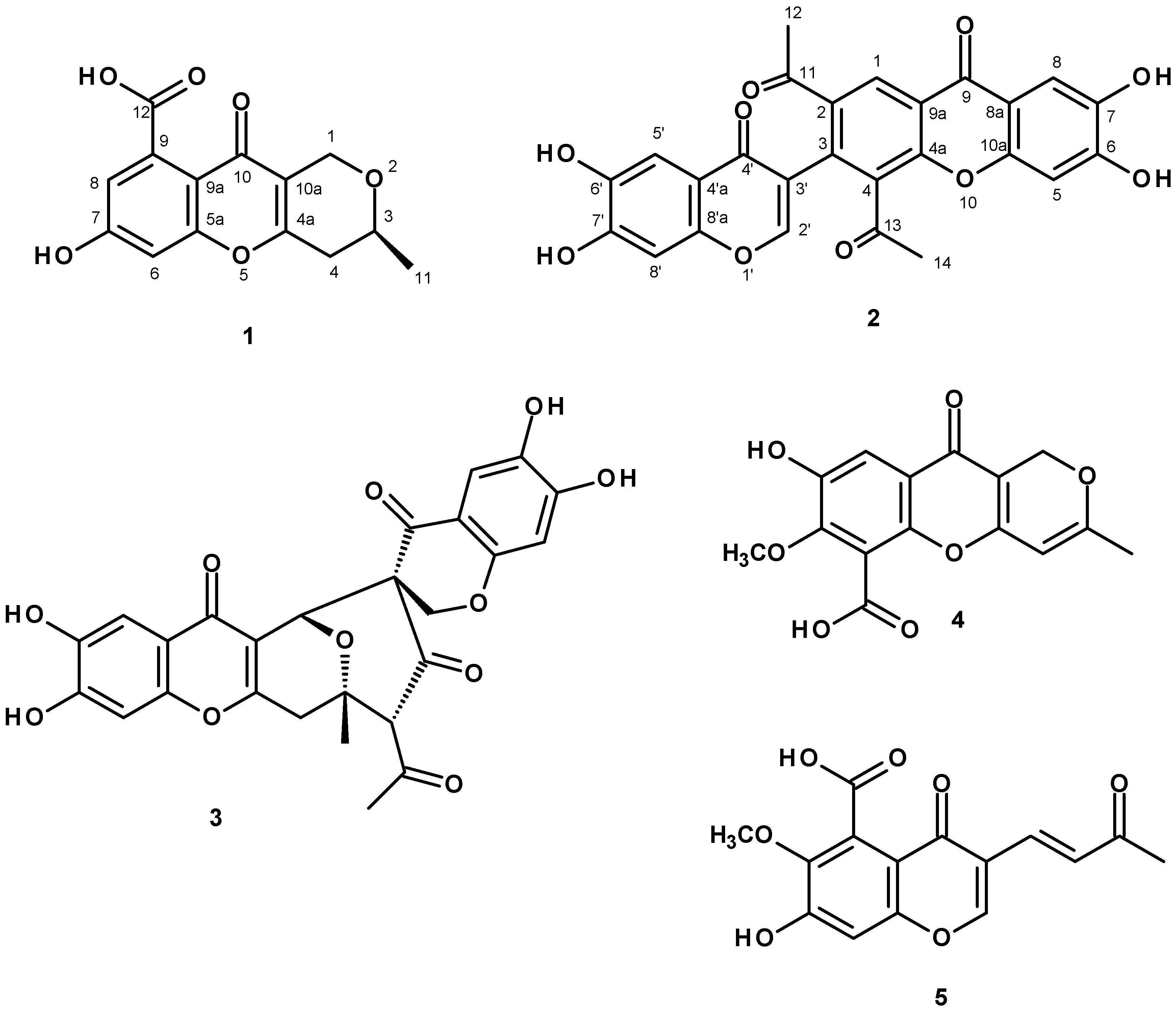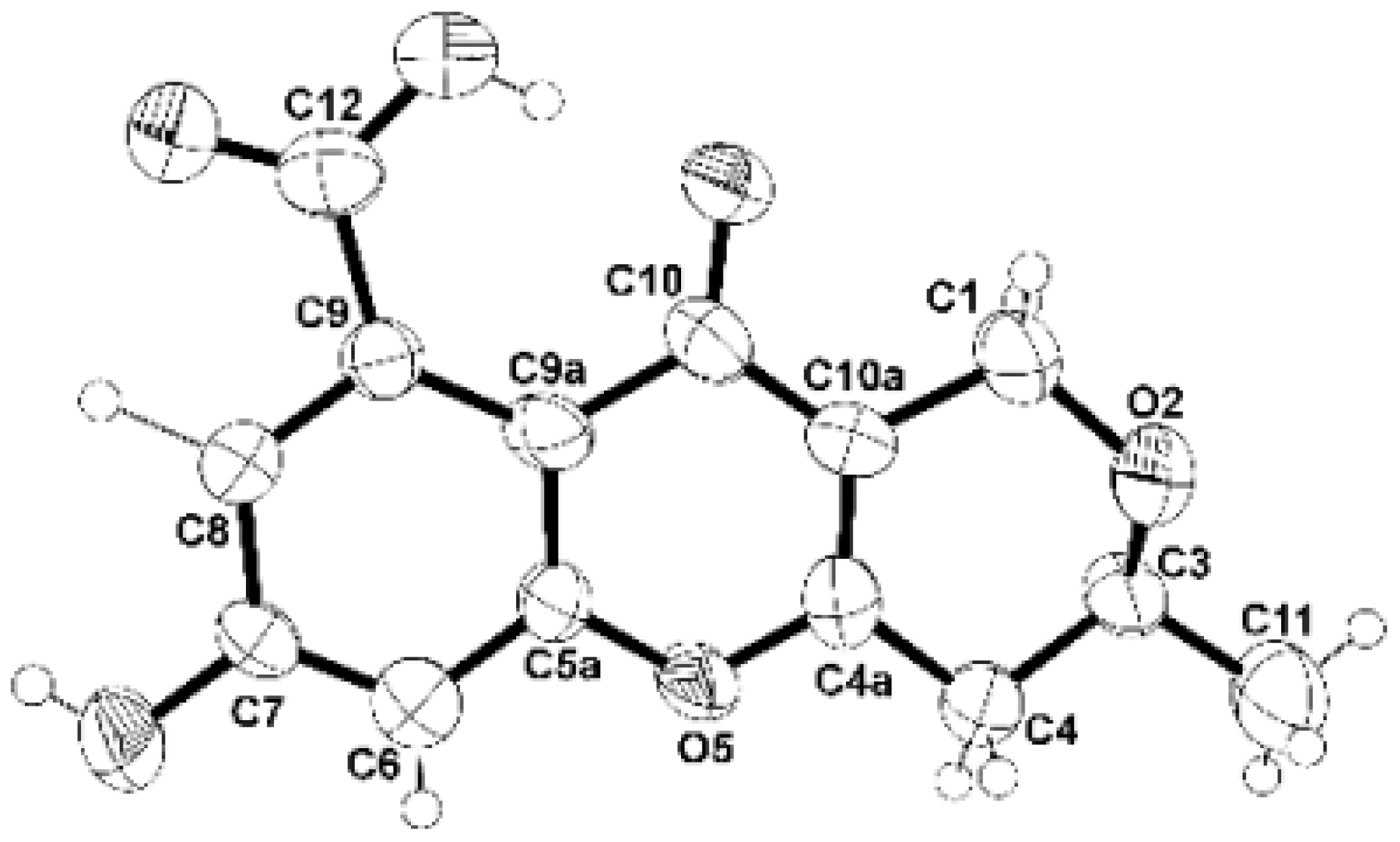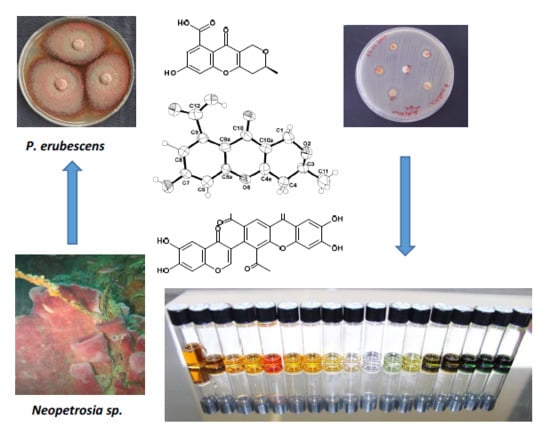Erubescensoic Acid, a New Polyketide and a Xanthonopyrone SPF-3059-26 from the Culture of the Marine Sponge-Associated Fungus Penicillium erubescens KUFA 0220 and Antibacterial Activity Evaluation of Some of Its Constituents
Abstract
1. Introduction
2. Results and Discussion
3. Experimental Section
3.1. General Experimental Procedures
3.2. Fungal Material
3.3. Extraction and Isolation
3.3.1. Erubescensoic Acid (1)
3.3.2. SPF-3059-26 (2)
3.4. X-Ray Crystal Structure of 1
3.5. Antibacterial Activity Bioassays
3.5.1. Bacterial Strains and Testing Conditions
3.5.2. Antimicrobial Susceptibility Testing
3.5.3. Biofilm Formation Inhibition Assay
3.5.4. Antibiotic Synergy Testing
4. Conclusions
Supplementary Materials
Author Contributions
Funding
Acknowledgments
Conflicts of Interest
References
- Visagle, C.M.; Houbraken, J.; Frisvad, J.C.; Hong, S.B.; Klaassen, C.H.W.; Perrone, G.; Seifert, K.A.; Vatga, J.; Yaguchi, T.; Samson, R.A. Identification and nomenclature of the genus Penicillium. Sud. Mycol. 2014, 78, 343–371. [Google Scholar] [CrossRef] [PubMed]
- Endo, A. A historical perspective on the discovery of statins. Proc. Jpn. Acad. Ser. B Phys. Biol. Sci. 2010, 86, 484–493. [Google Scholar] [CrossRef] [PubMed]
- Ma, H.G.; Liu, Q.; Zhu, G.L.; Liu, H.S.; Zhu, W.M. Marine natural products sources from marine-derived Penicillium fungi. J. Asian Nat. Prod. Res. 2016, 18, 92–115. [Google Scholar] [CrossRef] [PubMed]
- Kumla, D.; Pereira, J.A.; Dethoup, T.; Gales, L.; Freitas-Silva, J.; Costa, P.M.; Lee, M.; Silva, A.M.S.; Sekeroglu, N.; Pinto, M.M.M.; et al. Chromone derivatives and other constituents from cultures of the marine sponge-associated fungus Penicilium erubescens KUFA 0220 and their antibacterial activity. Mar. Drugs 2018, 16, 289. [Google Scholar] [CrossRef] [PubMed]
- Nerve Regeneration Promoters Containing Semaphorin Inhibitor as the Active Ingredient. Available online: https://data.epo.org/publication-server/rest/v1.0/publication-dates/20071003/patents/EP1306093NWB1/document.html (accessed on 7 July 2018).
- Fujita, K.I.; Nagamine, Y.; Ping, X.; Taniguchi, M. Mode of action of anhydrofulvic acid against Candida utilis ATCC 42402 under acidic condition. J. Antibiot. 1999, 52, 628–634. [Google Scholar] [CrossRef] [PubMed]
- Chin, M.R.; Zlotkowski., C.; Han, M.; Patel, S.; Eliasen, A.M.; Axelrod, A.; Siegel, D. Expedited access to vinaxanthone and chemically edited derivatives possessing neuronal tegenerative effects through ynone coupling reactions. ACS Chem. Neurosci. 2015, 6, 542–550. [Google Scholar] [CrossRef] [PubMed]
- Aoki, M.; Itezono, Y.; Shirai, H.; Nakayama, N.; Sakai, A.; Tanaka, Y.; Yamaguchi, A.; Shimma, N.; Yokose, K. Structure of a novel phospholipase C inhibitor, vinaxanthone (Ro 09-1450), produced by Penicillium vinaceum. Tetrahedron Lett. 1991, 32, 4737–4740. [Google Scholar] [CrossRef]
- Wrigley, S.K.; Latif, M.A.; Gibson, T.M.; Chicarelli-Robinson, M.I.; Williams, D.H. Structure elucidation of xanthone derivatives with CD4-binding activity from Penicillium glabrum (Wehmer) Westling. Pure Appl. Chem. 1994, 66, 2383–2386. [Google Scholar] [CrossRef]
- Kumagai, K.; Hosotani, N.; Kikuchi, K.; Kimura, T.; Saji, I. Xanthofulvin, a novel semaphoring inhibitor produced by a strain of Penicillium. J. Antibiot. 2003, 56, 610–616. [Google Scholar] [CrossRef] [PubMed]
- Stepanović, S.; Vuković, D.; Dakic, I.; Savić, B.; Švabic-Vlahović, M. A modified -plate test for quantification of staphylococcal biofilm formation. J. Microbiol. Methods 2000, 40, 175–179. [Google Scholar] [CrossRef]
- Stepanović, S.; Vuković, D.; Hola, V.; Di Bonaventura, G.; Djukić, S.; Ćirković, I.; Ruzicka, F. Quantification of biofilm in microtiter plates: Overview of testing conditions and practical recommendations for assessment of biofilm production by staphylococci. Apmis 2007, 115, 891–899. [Google Scholar] [CrossRef] [PubMed]
- Cegelski, L.; Marshall, G.R.; Eldridge, G.R.; Hultgren, S.J. The biology and future prospects of of antivirulence therapies. Nat. Rev. Microbiol. 2008, 6, 17–27. [Google Scholar] [CrossRef] [PubMed]
- Miquel, S.; Lagrafeuille, R.; Souweine, B.; Forestier, C. Anti-biofilm activity as a health issue. Front. Microbiol. 2016, 7, 1–14. [Google Scholar] [CrossRef] [PubMed]
- Sheldrick, G.M. A short story of SHELX. Acta Cryst. 2008, 64, 112–122. [Google Scholar] [CrossRef] [PubMed]
- Simões, R.R.; Aires-de-Sousa, M.; Conceicao, T.; Antunes, F.; da Costa, P.M.; de Lencastre, H. High prevalence of EMRSA-15 in Portuguese public buses: A worrisome finding. PLoS ONE 2011, 6, e17630. [Google Scholar] [CrossRef] [PubMed]
- Bessa, L.J.; Barbosa-Vasconcelos, A.; Mendes, A.; Vaz-Pires, P.; Martins da Costa, P. High prevalence of multidrug-resistant Escherichia coli and Enterococcus spp. in river water, upstream and downstream of a wastewater treatment plant. J. Water Health 2014, 12, 426–435. [Google Scholar] [CrossRef] [PubMed]
- Clinical and Laboratory Standards Institute (CLSI). Performance Standards for Antimicrobial Susceptibility Testing, 27th ed.; Wayne: Wayne, PA, USA, 2017. [Google Scholar]
- Clinical and Laboratory Standards Institute (CLSI). Performance Standards for Antimicrobial Disk Susceptibility Tests, 11th ed.; Wayne: Wayne, PA, USA, 2012. [Google Scholar]
- Clinical and Laboratory Standards Institute (CLSI). Methods for Dilution Antimicrobial Susceptibility Tests for Bacteria That Grow Aerobically, 10th ed.; Wayne: Wayne, PA, USA, 2015. [Google Scholar]
- Buttachon, S.; Ramos, A.A.; Inácio, Â.; Dethoup, T.; Gales, L.; Lee, M.; Costa, P.M.; Silva, A.M.S.; Sekeroglu, N.; Rocha, E.; et al. Bis-indolyl benzenoids, hydroxypyrrolidine derivatives and other constituents from cultures of the marine sponge-associated fungus Aspergillus candidus KUFA0062. Mar. Drugs 2018, 16, 119. [Google Scholar] [CrossRef] [PubMed]
Sample Availability: Not available. |


| Position | δC, Type | δC (J in Hz) | HMBC |
|---|---|---|---|
| 1 | 61.6, CH2 | 4.56, d (14.9) | C-3, 4a, 10a |
| 4.33, d (14.9) | C-10a | ||
| 3 | 69.4, CH | 3.83, m | C-1 |
| 4 | 33.5, CH2 | 2.66, d (17.3) | C-3, 4a, 11 |
| 2.56, dd (17.3, 9.8) | C-3, 4a, 10a | ||
| 4a | 160.0, C | - | |
| 5a | 157.4, C | - | |
| 6 | 102.0, CH | 6.78, s | 4 |
| 7 | 138.2, C | - | |
| 8 | 111.8, CH | 6.27, s | |
| 9 | - | - | |
| 9a | 119.7, C | - | |
| 10 | 173.0, CO | - | |
| 10a | 115.3, C | - | |
| 11 | 20.8, CH3 | 1.28, d (6.2) | C-3, 4 |
| 12 | 161.8, CO | - |
| Position | δC, Type | δC (J in Hz) | HMBC |
|---|---|---|---|
| 1 | 126.4, CH | 8.58, s | C-3, 4a, 9, 11 |
| 2 | 135.9, C | - | |
| 3 | 132.7, C | - | |
| 4 | 133.5, C | - | |
| 4a | 152.5, C | - | |
| 5 | 102.9, CH | 6.93, s | C-7, 8a, 9, 10a |
| 6 | 150.7, C | - | |
| 7 | 144.6, C | - | |
| 8 | 108.6, CH | 7.48, s | C-7, 8a, 9, 10a |
| 8a | 115.7, C | - | |
| 9 | 173.4, CO | - | |
| 9a | 119.8, C | ||
| 10a | 154.5, C | ||
| 11 | 199.2, CO | ||
| 12 | 29.2, CH3 | 2.55, s | C-2, 11 |
| 13 | 201.3, CO | - | |
| 14 | 32.3, CH3 | 2.53, s | C-4, 13 |
| 2′ | 152.9, CH | 8.13, s | C-3′, 4′, 8′a, 9′ |
| 3′ | 120.8, C | - | |
| 4′ | 173.7, CO | - | |
| 4′a | 113.4, C | - | |
| 5′ | 107.9, CH | 7.28, brs | C-4’, 6′, 7′, 8′a |
| 6′ | 152.8, C | - | |
| 7′ | 145.0, C | - | |
| 8′ | 103.1, CH | 6.94, s | C-4′, 6′, 7′ |
| 8′a | 151.1, C |
| Compound | Concentration (mg/L) | OD ± SD | Classification |
|---|---|---|---|
| None | 0 | 0.361 ± 0.159 | strong |
| 1 | 64 | 0.188 ± 0.012 | moderate |
| 2 | 64 | 0.195 ± 0.012 | moderate |
| 3 | 32 | 0.246 ± 0.038 | moderate |
| 4 | 64 | 0.172 ± 0.024 | weak |
| 5 | 64 | 0.194 ± 0.013 | moderate |
| E. coli SA/2 (ESBL) | E. faecalis B3/101 (VRE) | S. aureus 66/1 (MRSA) | ||||
|---|---|---|---|---|---|---|
| CTX | VAN | OXA | ||||
| Compound | Distribution | MIC | Distribution | MIC | Distribution | MIC |
| Antibiotic | - | 512 | - | 1024 | - | 64 |
| Antibiotic +1 | - | 512 | - | 1024 | - | 64 |
| Antibiotic +2 | - | 128 | - | 1024 | - | 128 |
| Antibiotic +3 | - | 512 | - | 1024 | - | 64 |
| Antibiotic +4 | - | 512 | - | 1024 | - | 64 |
| Antibiotic +5 | - | 512 | - | 1024 | - | 64 |
© 2019 by the authors. Licensee MDPI, Basel, Switzerland. This article is an open access article distributed under the terms and conditions of the Creative Commons Attribution (CC BY) license (http://creativecommons.org/licenses/by/4.0/).
Share and Cite
Kumla, D.; Dethoup, T.; Gales, L.; Pereira, J.A.; Freitas-Silva, J.; Costa, P.M.; Silva, A.M.S.; Pinto, M.M.M.; Kijjoa, A. Erubescensoic Acid, a New Polyketide and a Xanthonopyrone SPF-3059-26 from the Culture of the Marine Sponge-Associated Fungus Penicillium erubescens KUFA 0220 and Antibacterial Activity Evaluation of Some of Its Constituents. Molecules 2019, 24, 208. https://doi.org/10.3390/molecules24010208
Kumla D, Dethoup T, Gales L, Pereira JA, Freitas-Silva J, Costa PM, Silva AMS, Pinto MMM, Kijjoa A. Erubescensoic Acid, a New Polyketide and a Xanthonopyrone SPF-3059-26 from the Culture of the Marine Sponge-Associated Fungus Penicillium erubescens KUFA 0220 and Antibacterial Activity Evaluation of Some of Its Constituents. Molecules. 2019; 24(1):208. https://doi.org/10.3390/molecules24010208
Chicago/Turabian StyleKumla, Decha, Tida Dethoup, Luís Gales, José A. Pereira, Joana Freitas-Silva, Paulo M. Costa, Artur M. S. Silva, Madalena M. M. Pinto, and Anake Kijjoa. 2019. "Erubescensoic Acid, a New Polyketide and a Xanthonopyrone SPF-3059-26 from the Culture of the Marine Sponge-Associated Fungus Penicillium erubescens KUFA 0220 and Antibacterial Activity Evaluation of Some of Its Constituents" Molecules 24, no. 1: 208. https://doi.org/10.3390/molecules24010208
APA StyleKumla, D., Dethoup, T., Gales, L., Pereira, J. A., Freitas-Silva, J., Costa, P. M., Silva, A. M. S., Pinto, M. M. M., & Kijjoa, A. (2019). Erubescensoic Acid, a New Polyketide and a Xanthonopyrone SPF-3059-26 from the Culture of the Marine Sponge-Associated Fungus Penicillium erubescens KUFA 0220 and Antibacterial Activity Evaluation of Some of Its Constituents. Molecules, 24(1), 208. https://doi.org/10.3390/molecules24010208










